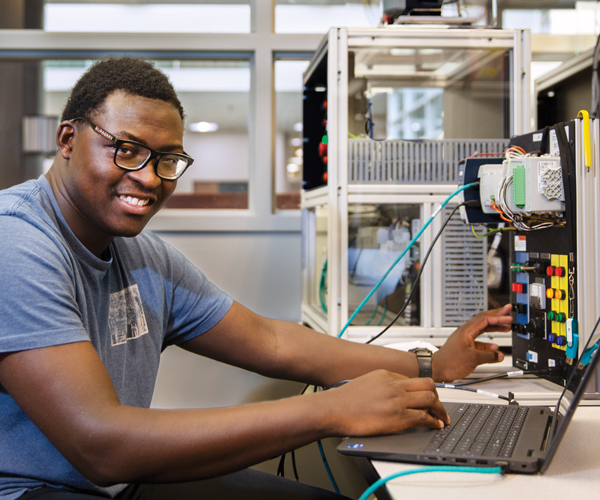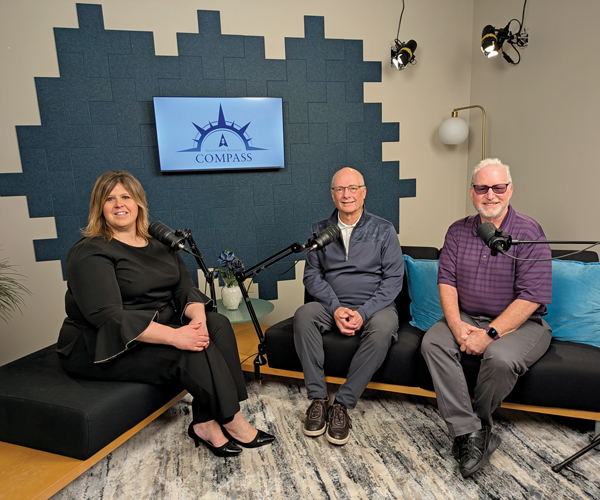With all the projects happening in the area, the stage is set for East 105th Street’s return to its roots of being called “The Gold Coast.” Projects include: Twelve Literary Arts’ Baldwin House, The Madison, Third Space, Fisher House, The New EastSide Market and the recently opened GlenVillage inside of Glenville Circle North apartments.
“The focus on East 105th Street, heading north into Brahtenal, is to make it seamless with University Circle,” says Ward 9 Cleveland City Councilman Kevin Conwell.
Fisher House and Glenville Circle North Apartments with GlenVillage are each $15 million projects located between Ashbury and Superior avenues. The latter includes an outdoor amphitheater, one- and two-bedroom units, co-working offices and incubator space for seven black-owned businesses.
“This is about the future of the city of Cleveland,” Mayor Frank G. Jackson said during the grand opening. The development is part of his $65 million Neighborhood Transformation Initiative (NTI), launched in 2017, to provide healthy, sustainable and equitable opportunities to build wealth and stabilize neighborhoods.
Etop Udoh, from North Carolina by way of Nigeria, has lived in Glenville Circle North apartments since August 2019. A graduate student studying medical physiology at Case Western Reserve University, Udoh was among the first to move in the building.
“This complex reminds me of home,” he says. “It’s close to the campus, one of the nicest places in the area.”
Udoh says the grand opening of GlenVillage brings more traffic to the building. Now, he can go downstairs to get food, his beard shaped up, buy clothes and mingle with people.
“It doesn’t feel dead anymore,” Udoh says. “It’s good to see young black professionals. It’s a great turnout. I hope the energy stays the same.”
Esayla Williams’ LaMocha Boutique is one of the seven African American businesses located in GlenVillage.
“I thought being a part of this program would be an amazing opportunity,” says Williams, who is originally from Lee-Harvard. She says being on this side of town is new to her and LaMocha Boutique, which began two years ago as an online store. She’s enjoying it and finding it rewarding.
“The neighborhood is amazing,” says Williams. “I didn’t know what to expect, but the neighbors have been overpouring with support. They have come in droves to make sure we’re successful.”
The grand opening of GlenVillage completes Phase I of redevelopment along East 105th Street.
“It’s coming back alive,” says Yvonne Wilson, who with her husband, Walter Wilson, owns W&W Foods next door to Fisher House. Their store has been on the corner of East 105th Street and Lee Avenue for 48 years. They also live in the neighborhood. Walter, 73, who loves to impart knowledge on his customers, says they’ve sustained with fortitude, strength of character, strong parenting, desire for the truth and respect of others. With the new developments, they have received some support from the city — a new roof. The Wilsons, both playing an active role in the survival of their store, plan to stay.
“I’m not just here to make money,” says Walter. “If that was the case, I would’ve left a long time ago. I grew up in this neighborhood. I’m here to give [the residents] an idea of something else they can do. I stay here to give a sense of pride.
“It’s been a struggle,” Walter continues. “One building doesn’t change the circumstances. It’s going to take a lot more.”
Conwell, who knows the community like the back of his hand, promises more is to come. The councilman explains that Phase 2 should be complete next year. It extends along East 105th Street from East Boulevard down to Greenlawn Avenue, entailing a $14 million streetscape. Conwell says there hasn’t been a streetscape along East 105th Street since 1978. This project will resurface the street and provide storefront renovations to existing businesses, as well as install new sidewalks and LED lighting with cameras.
The Wilsons are planning for the renovations. Conwell says it will cause their storefront to blend in with GlenVillage. Conwell also is looking to break ground in May on a Volunteers of America site, an $8 million project behind Fisher House. And the old Harry E. Davis building on Churchill Avenue is on the table for demolition. It could be replaced with affordable housing.
“The goal is to bring ‘The Gold Coast’ back,” says Conwell. “All of this is policy, managing policy and getting money from the city and the county.”
Conwell, along with the city, started working on this plan several years ago, when the neighborhoods were redistricted and he acquired parts of old Ward 8.
“It takes a lot of political capital,” says Conwell, in response to why Glenville was selected as the first East Side community in Jackson’s initiative. “We want to create a ripple effect, shooting from University Circle going north.”
Twelve Literary Arts’ Baldwin House, along with The Madison and Third Space across the street, adds another dynamic to the community — the arts. Even Conwell, a drummer, looks forward to performing at the amphitheater with his band, Footprints, in the summer. The Madison houses art students. Third Space hosts activities and community events. Meanwhile, Twelve Literary Arts’ Baldwin House is home to seven to 10 writers-in-residence.
When asked how it feels being on East 105th Street in Glenville during this transformation, Daniel Gray Kontar, executive director of Twelve Literary Arts, responds, “Wow!”
The poet and former journalist describes it as “a very spiritual experience.” He explains that the area gave birth to the Black Poets Society, and Twelve Literary Arts started in the Cleveland Schools of Arts, which at the time was housed at Harry E. Davis School. He also mentions that Langston Hughes once lived on Ashbury. “It’s an important place,” he says.
For Kontar and others, the foreseeable challenge is to make sure development along East 105th Street doesn’t go in the direction of development in other parts of the city and across the country —
pushing folks out — but welcoming and inviting all narratives.
“We want to create a Glenville that all people can be a part of, that doesn’t force us to have to leave because of higher taxes,” says Kontar. “You can have development without gentrification. I hope we can be studied as a model.”
If all goes according to Conwell’s plans, it will.




